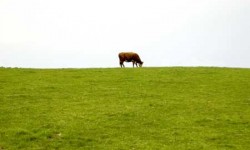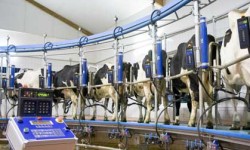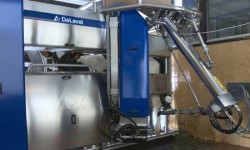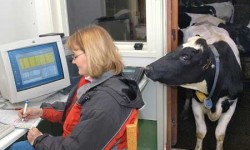
Milking on demand
It is an ordinary Mondayat milk-machinery producer DeLaval’s development facility in Tumba, outside Stockholm. Soothing music streams from the loudspeakers in the barn, and spring sunshine floods through the windows. A few cows saunter about; others rest on sawdust-covered mattresses. The scene is more reminiscent of a spa for overstressed city dwellers than a milk-production facility.
Milking machines from Swedish company DeLaval make it possible
for cows to just about milk themselves.
It is an ordinary Mondayat milk-machinery producer DeLaval’s development facility in Tumba, outside Stockholm. Soothing music streams from the loudspeakers in the barn, and spring sunshine floods through the windows. A few cows saunter about; others rest on sawdust-covered mattresses. The scene is more reminiscent of a spa for overstressed city dwellers than a milk-production facility.
However, there is activity in one part of the premises. A number of the cows have lined up, waiting for their turn to step into the VMS
(voluntary milking system), a fully automatic milking system that allows cows to be milked when they want.
The VMS, a high-tech, computer-controlled machine, could not be further removed from old-fashioned hand milking. When a cow steps into the milking machine, her teats are first washed. The robotic milking apparatus then locates the teats by means of laser beams. Once milking starts, the quantity and quality of the milk produced by each teat is individually measured. The teat cups automatically retract as soon as milking is complete. Data relating to the milking session is stored in the computer system. If there is some problem with the milking session or the cow, an alert is sent to the dairy farmer via SMS. In theory, the dairy farmer doesn’t even need to be present in the barn; he can monitor operations from a tractor … or the beach.
“We know that many young people are hesitant to take over their parents’ farms in view of the workload and the almost inhuman working hours,” says DeLaval Product Manager Per Edstam. “Being a dairy farmer still requires involvement with the animals and land, but this sort of equipment makes it more like a regular job.”
However, DeLaval is not only interested in satisfying farmers. Promoting the animals’ well-being is part of the company’s fundamental policy.
“Well-being of the animals involves two main aspects,” says Edstam. “One has to do with the circumstance in which healthy, productive animals produce high-quality milk. The other has to do with ethics, environmental impact and the profitability and competitiveness of production systems.”
More than 2,500 units of the VMS system, which was introduced in 2000 and which represents the high-tech end of DeLaval’s product selection, have been sold. But the company’s goal is that milk producers, both small and large, will think of DeLaval whenever they need something. The product selection accordingly encompasses all sorts of milking machines, from simple machines that milk one cow at a time to the advanced VMS system. The company also offers equipment for milking sheep, goats and even buffalo, in addition to cows.
In a number of large countries,such as Brazil, Argentina and New Zealand, it is common for farmers to employ free-range grazing, whereby animals are allowed to roam more or less freely over the pastures. For these markets, DeLaval offers a solution that involves the cows being guided into a slowly revolving carousel. From the middle of the carousel, a single person can easily and comfortably attach the milking apparatus to the cows, as well as detach it. Once they are milked, the cows are guided back out of the carousel. This system, like the VMS, allows for computerized analysis of the milk. In the event of an abnormal result, the cow in question can be guided into an enclosed pasture for examination.
Regardless of the kind of milking system a customer chooses, there is a common denominator – a vacuum pump at the core of the system. Strict requirements ensure that the vacuum pumps function efficiently and reliably in order to ensure optimal milking results and maintain udders in good condition. DeLaval offers both belt-drive and direct-drive vacuum pumps. Direct-drive pumps feature lower noise levels and consume less oil. DeLaval’s direct-drive pumps can also be furnished with a frequency control that regulates the speed of the pump.
“Washing requires the highest possible vacuum, but the pump can run more slowly for milking,” says Product Manager Sofia Brändefors. “A lower speed entails less noise and lower energy consumption. Our test results show that energy savings of 30 to 65 percent can be achieved by installing a frequency control on a vacuum pump.”
Looking to the future,DeLaval sees computerized data collection as potentially providing the most signifi-cant development opportunities. An example of what can be done is the DCC (DeLaval Cell Counter) cell-count calculator used to measure milk quality, which provides an early warning of udder problems. DeLaval’s researchers work continuously to find sophisticated methods for improving and refining the milking process and simplifying the work of the modern milk producer.
SKF and DeLaval
DeLaval has chosen SKF as a supplier for a number of applications. The cow carousel used in connection with free-range grazing features a cylindrical roller bearing and a deep groove ball bearing. “This sort of application places great demands on the bearings, due to the effects of the cows’ urine and droppings,” says Per Edstam, a DeLaval product manager. SKF supplies a stainless-steel swivel head for the VMS milking system consisting of a shaft, a stainless-steel deep groove ball bearing, a small actuator and a Multitec coupling. This unit is also installed by SKF.
DeLaval’s vacuum pumps are fitted with special SKF deep groove ball bearings featuring removable seals. This enables seal change and relubrication to extend bearing service life.








